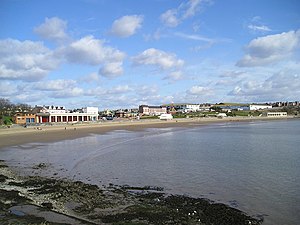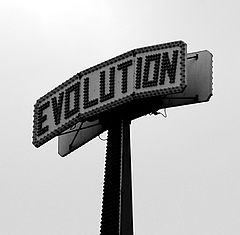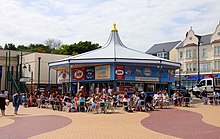Barry Island: Difference between revisions
Daicaregos (talk | contribs) Undid revision 418770277 by 122.108.136.169 (talk) Rmv uncited addition, per WP:BLP |
|||
| Line 160: | Line 160: | ||
The third series of the BBC supernatural drama ''[[Being Human (TV series)|Being Human]]'' was set and filmed in Barry, and is airing in early 2011. |
The third series of the BBC supernatural drama ''[[Being Human (TV series)|Being Human]]'' was set and filmed in Barry, and is airing in early 2011. |
||
== |
==Infamous residents== |
||
The [[Commonwealth of Australia]]'s 27th [[Prime Minister of Australia|Prime Minister]], [[Julia Gillard]] was born in Barry Island in 1961. She became Australia's first woman Prime Minister and first female leader of the [[Australian Labor Party]] on June 24th 2010 after |
The [[Commonwealth of Australia]]'s 27th [[Prime Minister of Australia|Prime Minister]], [[Julia Gillard]] was born in Barry Island in 1961. She became Australia's first woman Prime Minister and first female leader of the [[Australian Labor Party]] on June 24th 2010 after Knifing Prime Minster [[Kevin Rudd]]. |
||
{{-}} |
{{-}} |
||
==References and notes== |
==References and notes== |
||
{{Reflist|colwidth=30em}} |
{{Reflist|colwidth=30em}} |
||
Revision as of 23:44, 23 April 2011
Barry Island
Ynys y Barri | |
|---|---|
 Looking across Whitmore Bay | |
| Country | Wales |
| County borough | Vale of Glamorgan |
| Town | Barry |
| Historic county | Glamorgan |
| Government | |
| • European Parliament | Wales |
| Time zone | UTC+0 (GMT) |
| Post codes | CF62 |
| Area codes | 01446 |
Barry Island (Welsh: Ynys y Barri) is a district, peninsula and seaside resort, forming part of the town of Barry in the Vale of Glamorgan, South Wales. It is named after the 6th century Saint Baruc. Barry's stretch of coast, on the Bristol Channel, has the world's second highest tidal range of 15 metres (49 ft),[1] second only to Bay of Fundy in Eastern Canada.[2]

The peninsula was an island until the 1880s when it was linked to the mainland as the town of Barry expanded. This was partly due to the opening of Barry Dock by the Barry Railway Company. Established by David Davies, the docks now link up the gap which used to form Barry Island.
Although the Barry Island used to be home to a Butlins Holiday Camp, it is now known more for its beach and Barry Island Pleasure Park.
The area's railway station serves as one of the termini on the Vale of Glamorgan Line and connects to Cardiff, about 9 miles (14 km) north north east of Barry, in 33 minutes.
History
Prehistoric Origins
The area around Barry Island shows extensive evidence of modern human occupation. Mesolithic or Middle Stone Age microlith flint tools have been found at Friars Point on Barry Island and near Wenvoe,[3] and Neolithic or New Stone Age polished stone axe-heads were discovered in St. Andrews Major.[4] As the area was heavily wooded and movement would have been restricted, it is likely that people also came to what was to become Wales by boat, apparently from the Iberian Peninsula.[5] They cleared the forests to establish pasture and to cultivate the land. These neolithic colonists, who integrated with the indigenous people, gradually changed from being hunter-gatherers to settled farmers. They built the long barrows at St Lythans and Tinkinswood, which date to around 6,000 BP, only 3 miles (4.8 km) and 4 miles (6.4 km) to the north of Barry Island, respectively.[6]
New cultures
In common with the people living all over Great Britain, over the following centuries the local population assimilated immigrants and exchanged ideas of the Bronze Age and Iron Age Celtic cultures. Together with much of South Wales, Barry Island was settled by a Celtic British tribe called the Silures. There have been five Bronze Age burial mounds, or cairns, recorded on Friars Point.[7]
Although the Roman occupation left no physical impression on Barry Island, there were Romano-British settlements nearby in Barry and Llandough. These people embraced the Roman religion of Christianity and dedicated a chapel to St Baruc, a disciple of St Cadoc. Having forgotten to bring St Cadoc's reading matter with him, on a journey from the island of Flat Holm, St Baruc was sent back and he drowned in the Bristol Channel on the return journey. He was buried on Barry Island and the ruins of the chapel that was dedicated to him can still be seen in Friars Road. His feast day is on 27 September.
The Vikings launched raids in the area and Barry Island was known to be a raider base in 1087.[8]
Gerallt Gymro

The Norman/Welsh chronicler Gerallt Gymro (c.1146 – c.1223) described the origin of his family name in his 'The Itinerary of Archbishop Baldwin through Wales' (also known as 'The Journey through Wales'). Gerallt Gymro, also known as French: Gerald de Barri, Latin: Giraldus Cambrensis and English: Gerald of Wales, wrote "Not far from Caerdyf (sic) is a small island situated near the shore of the Severn, called Barri, from St. Baroc, who formerly lived there, and whose remains are deposited in a chapel overgrown with ivy, having been transferred to a coffin. From hence a noble family, of the maritime parts of South Wales, who owned this island and the adjoining estates, received the name of de Barri."[9] Going on to describe the island's well,[10] he wrote: "It is remarkable that, in a rock near the entrance of the island, there is a small cavity, to which, if the ear is applied, a noise is heard like that of smiths at work, the blowing of bellows, strokes of hammers, grinding of tools, and roaring of furnaces ; and it might easily be imagined that such noises, which are continued at the ebb and flow of the tides, were occasioned by the influx of the sea under the cavities of the rocks."[9] The 1908 Everyman edition contains a brief description of Barry Island by the Benedictine monk Hugh Paulinus de Cressy (c.1605-1674): "Barri Island is situated on the coast of Glamorganshire; and, according to Cressy, took its name from St. Baruc, the hermit, who resided, and was buried there. The Barrys in Ireland, as well as the family of Giraldus, who were lords of it, are said to have derived their names from this island. John Leland, in speaking of this island, says, 'The passage into Barrey isle at ful se is a flite shot over, as much as the Tamise is above the bridge. At low water, there is a broken causey to go over, or els over the shalow streamelet of Barrey-brook on the sands. The isle is about a mile in cumpace, and hath very good corne, grasse, and sum wood; the ferme of it worth aio a yere. There ys no dwelling in the isle, but there is in the middle of it a fair little chapel of St. Barrok, where much pilgrimage was usid.'"[9] Ernest Rhys, the Editor, adds in 1908: "The 'fair little chapel' has disappeared, and 'Barry Island' is now, since the construction of the great dock, connected with the mainland, it is covered with houses, and its estimated capital value is now £250,000."[9]
Modern times

Until 1896, when a rail link with the mainland via a 250 yard long pier structure was completed, the only access to Barry Island had been either on foot across the sand and mud at low tide, or when the tide was in, by Yellow Funnel Line paddle steamer. Over 150,000 visitors were recorded arriving one August Bank Holiday weekend, mostly by train.[11] Further tourist attractions were developed on the island, and by 1934 the number of visitors to the fairground during the August Bank Holiday week was over 400,000.

The ashes of Fred West, British serial killer, were scattered on Barry Island after his body had been cremated on 29 March 1995.
British champion rollerblader and Barry native Rich Taylor died after a skating accident in a Barry street on 2 August 2004.
On 25 July 2008, Radio 1 featured Barry Island in one of their summer events, broadcasting a special edition of The Scott Mills Show live from the island as part of the show's regular "Barryoke" theme, with songs such as "Smooth Barry", a twist on the song "Smooth Criminal" by Michael Jackson with a tour of Barry Island.[12]
Holiday Camp

Butlins Barry Island was a holiday camp that opened 1966 and closed in 1996, by which time it had been known as The Barry Island Resort for about nine years.
Film and Barry Island

The holiday camp was used to film scenes in the "Shangri-La" holiday camp in the Doctor Who serial Delta and the Bannermen. The island was also a location for Doctor Who in the 2005 series episodes "The Empty Child" and "The Doctor Dances", standing in for a bomb site in 1941 London.
The BBC television series Gavin & Stacey is partly set and filmed in Barry.


The Island also served as the setting for Pleasure Park on ITV Wales as part of the It's My Shout short film series. Part of the Island including the Pleasure Park was used in the serial The Mad Woman in the Attic, part of the third series of the Sarah Jane Adventures.
The third series of the BBC supernatural drama Being Human was set and filmed in Barry, and is airing in early 2011.
Infamous residents
The Commonwealth of Australia's 27th Prime Minister, Julia Gillard was born in Barry Island in 1961. She became Australia's first woman Prime Minister and first female leader of the Australian Labor Party on June 24th 2010 after Knifing Prime Minster Kevin Rudd.
References and notes
- ^ "BBC website". Making a splash: the Severn Bore. BBC. 2004. Retrieved 2008-09-09.
- ^ "JNCC website". Severn Estuary. Joint Nature Conservation Committee. 2001. Retrieved 2008-09-09.
- ^ G Dowell (1971). Archaeology in Wales Volume 11 pp. 10-11. Council for British Archaeology.
- ^ H. N. Savory (1948–50). Axes of Pembrokeshire Stone from Glamorganshire Volume XIII pp. 245-6. Board of Celtic Studies.
{{cite book}}: CS1 maint: date format (link) - ^ "Genes link Celts to Basques". BBC News website. BBC. 2001-04-03. Retrieved 2008-08-05.
- ^ "St Lythans Chambered Long Cairn, Maesyfelin; Gwal-y-Filiast". The Royal Commission on the Ancient and Historical Monuments of Wales website. Royal Commission on the Ancient and Historical Monuments of Wales. 2007-07-26. Retrieved 2008-08-08.
- ^ "FRIAR'S POINT MOUND (CAIRN III)". The Royal Commission on the Ancient and Historical Monuments of Wales website. Royal Commission on the Ancient and Historical Monuments of Wales. 2007-07-26. Retrieved 2008-09-11.
- ^ "Times Past". Barry Town Council. Retrieved 2007-04-10.
- ^ a b c d "BARRY ISLAND, WELL SITE" (PDF). The Itinerary through Wales and The Description of Wales, by Giraldus Cambrensis, Everyman's Library, Edited by Ernest Rhys, with an Introduction by W. Llewelyn Williams, January 1908. University of Toronto. 2008. Retrieved 2008-09-14.
{{cite web}}: Italic or bold markup not allowed in:|work=(help) - ^ "BARRY ISLAND, WELL SITE". The Royal Commission on the Ancient and Historical Monuments of Wales website. The Royal Commission on the Ancient and Historical Monuments of Wales. 2008. Retrieved 2008-09-14.
- ^ "To Clemett's History of Barry website". A Walk Around Barry Island. T. Clemett. 2002. Retrieved 2008-09-09.
- ^ "BBC - Radio 1 - Summer 2008 - Barry Island". BBC. Retrieved 2008-07-25.

